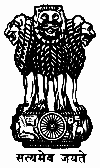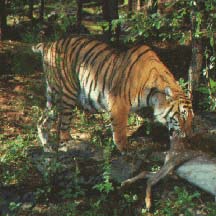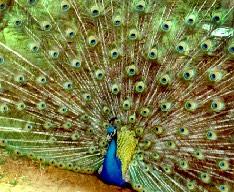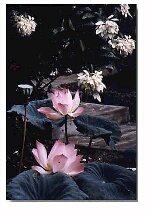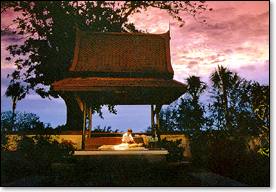|
National Symbols |
Descriptions |
|
|
Indian Flag The flag is a horizontal tricolor in equal proportion of deep saffron on the top, white in the middle and dark green at the bottom. The ratio of the width to the length of the flag is two to three. In the center of the white band, there is a wheel in navy blue to indicate the Dharma Chakra, the wheel of law in the Sarnath Lion Capital. Its diameter approximates the width of the white band and it has 24 spokes. The saffron stands for courage, sacrifice and the spirit of renunciation; the white, for purity and truth; the green for faith and fertility. |
|
|
National Emblem The national emblem of India is a replica of the Lion of Sarnath, near Varanasi in Uttar Pradesh. The Lion Capital was erected in the third century, BC by Emperor Ashoka to mark the spot where Buddha first proclaimed his gospel of peace and emancipation to the four quarters of the universe. The national emblem is thus symbolic of contemporary India’s reaffirmation of its ancient commitment to world peace and goodwill. The four lions (one hidden from view) - symbolizing power, courage and confidence - rest on a circular abacus. The abacus is girded by four smaller animals - guardians of the four directions: the lion of the north, the elephant of the east, the horse of the south and the bull of the west. The abacus rests on a lotus in full bloom, exemplifying the fountainhead of life and creative inspiration. The motto ‘Satyameva Jayate’ inscribed below the emblem in Devanagari script means ‘truth alone triumphs’. |
|
|
National Animal - Tiger Large Asiatic carnivorous feline quadruped, Panthera Tigris, is maneless, of tawny yellow color with blackish transverse white belly, and proverbial for its power and its magnificence. There are very few tigers left in the world today. A decade ago, the tiger population in India had dwindled to a few hundred. The government of India, under its Project Tiger program, started a massive effort to preserve the tiger population. Today, thanks to Project Tiger, India’s population of tigers is in a comfortable position. |
|
|
National Bird - Peacock The male bird of species P. cristatus is a native of India, with striking
plumage and upper tail converts marked with iridescent ocelli, able to expand its tail erect like a fan in ostentatious display. Peacocks are
related to pheasants. Found wild in India (and also domesticated in villages) they live in jungle lands near water. They were once bred for
food but now hunting of peacocks is banned in India. The peahen has no plumage. These birds do not sound as beautiful as they look -
they have a harsh call. |
|
|
National Flower - Lotus The lotus or water lily is an aquatic plant of Nymphaea with broad
floating leaves and bright fragrant flowers that grow only in shallow waters. The leaves and flowers float and have long stems that
contain air spaces. The big attractive flowers have many petals overlapping
in a symmetrical pattern. The root functions are carried
out by rhizomes that fan out horizontally through the mud below the
water. Lotuses, prized for their serene beauty, are delightful to behold
as their blossoms open on the surface of a pond. In India, the sacred
lotus is legendary and much folklore and religious mythology is woven
around it. |
|
|
National Tree - Banyan The Indian fig tree, Ficus
bengalensis, has branches that root
themselves like new trees over a large area. The roots then give rise to
more trunks and branches. Because of this characteristic and its
longevity, this tree is considered immortal and is an integral part of the
myths and legends of India. Even today, the banyan tree is the focal
point of village life and the village council meets under the shade of
this tree. |
|
|
National Fruit - Mango A fleshy fruit of the tree Mangifera indica, the mango is one of the most important and widely cultivated fruits of the tropical world. Its juicy fruit is a rich source of vitamins A, C and D and can be eaten ripe
or used green for pickles. In India, there are over 100 varieties of mangoes in different sizes, shapes and colors. Mangoes have been cultivated in India from time immemorial. |
|
Jana gana mana adhinayaka jaya
he, Bharata bhagya vidhatha, Punjaba Sindhu Gujrata maratha, Dravida Utkala Banga. Vindhya Himachala Yamuna Ganga Uchchhala jaladi taranga Tava subha name jaage Tava subha asisa mage, Gahe tav jaya gatha. Jana gana mangala dayaka jaya he Bharata bhagya vidhata Jaya he, jaya he, jaya he, Jaya jaya jaya jaya he. |
National Anthem Rabindarnath Tagore's song Jana gana mana was adopted by the
Constituent Assembly as the National Anthem of India on the 24th of
January, 1950. The complete song consists of five stanzas. The first
stanza constitutes the full version of the national Anthem. It reads: |
|
Vande
Mataram! Sujalam, suphalam, malayaja-shitalam, doubtsasyashamalam, Mataram! Shubrajyoutsana, pulakitayaminim, Phullakusumita-drumadala-shobhinim, Suhasinim sumadhura-bhashinim, Sukhadam varadam, Mataram! |
National song Bankim
(Chandra Chatterjee's) Vande Mataram, which was a
source of inspiration to the people in their struggle for freedom has an
equal ststus with the National anthem. The following is a text of it's first
stanza.
|
|
GREGORIAN Saka date & month in the month
21/ 22 March 1 Chaitra 30/ 31 21 April 1 Vaishakha 31 22 May 1 Jyaishtha 31 22 June 1 Asadha 31 23 July 1 Sravana 31 23 August 1 Bhadra 31 23 October 1 Kartika 30 22 November 1 Agrahayana 30 22 December 1 Pausa 30 21 January 1 Magha 30 20 February 1 Phalguna 30 |
The National Calendar A uniform national calendar based on the (Saka) era, with Chaitra as its first month and a normal year of 365 days was adopted from 22 March,1957 along with the (Gregorian) Calendar. The dates of the National Calendar have a permanent correspondence with the dates of the Gregorian Calendar. |

